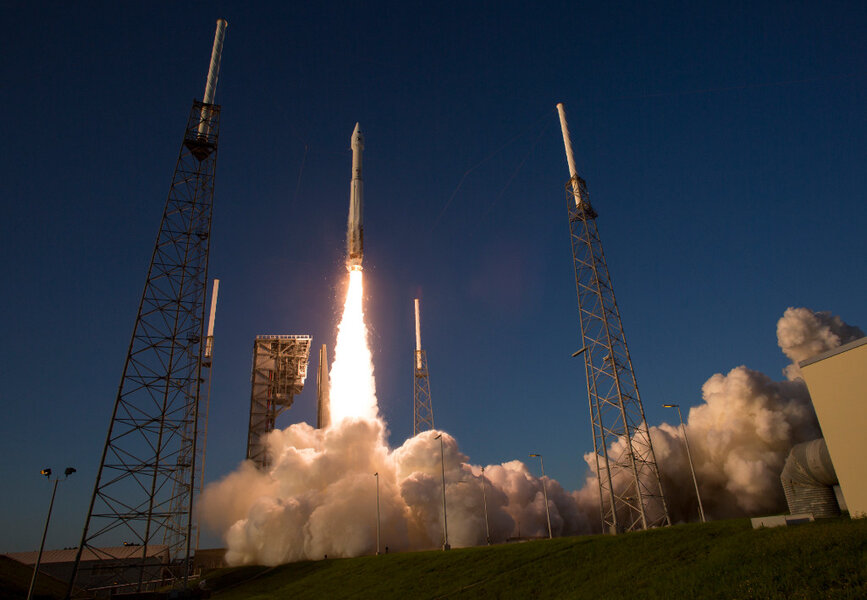Is Earth ready for an incoming asteroid? Not at all, says NASA scientist.
Loading...
Not long ago, news of a massive asteroid hurtling toward Earth would be a death sentence that humans, like the dinosaurs before us, would simply have to accept. But as near-Earth object detection has gotten more sophisticated, a new field called Planetary Defense has risen to meet the challenge of defending Earth from asteroids.
However, speaking at the annual meeting of the American Geophysical Union, Joseph Nuth, a researcher with NASA's Goddard Space Flight Center, warned that while asteroids and comets capable of resulting in mass extinctions are rare – as in, every-60-million-years rare – even small objects from space can cause a great deal of damage and the planet’s scientists are are still woefully unprepared to deal with the threat.
“It is really imperative that we reduce our reaction time,” Dr. Nuth said at the meeting. “The biggest problem, basically, is there’s not ... a lot we can do about it at the moment.”
Near-Earth objects are comets or asteroids whose orbits cross the Earth's. While most objects in space are tinier than a fleck of dust, some are bigger – up to many miles across.
Earth had a close call in 2014, when a comet knocked off course came dangerously close to Mars, which puts it in our cosmic neighborhood. Even if NASA did have a trustworthy deflection method, this comet was detected too late for it to work, Nuth argued.
"If you look at the schedule for high-reliability spacecraft and launching them, it takes five years to launch a spacecraft," he said. "We had 22 months of total warning."
Nuth suggests a two-pronged approach to improving avoiding this situation in the future.
The first line of defense is increased vigilance: an “observer spacecraft” searching for dangerous objects that may be headed toward Earth.
Second, Nuth recommends NASA keep a rocket capable of intercepting an asteroid in reserve and test it periodically, to "mitigate the possibility of a sneaky asteroid coming in from a place that’s hard to observe, like from the sun."
The key is early detection, agrees Cathy Plesko, a scientist at Los Alamos National Laboratory who uses computer models to design asteroid deflection scenarios. "We are very carefully doing our homework before finals week,” she told the Guardian. “We don’t want to be doing our calculations [as] something is coming. We need to have this work done.”
There are currently two potential methods of asteroid defense: a nuclear warhead or a kinetic impactor, which Dr. Plesko compares to a giant cannonball. Although cannons seem primitive compared to a nuclear bomb, in this case they are the better option, she argues.
"Cannonball technology is actually very good technology. Intercepting an object at high speed actually ends up being more effective than high explosives,” Plesko said at the meeting.
Kinetic impactors require precise calculations that need decades of planning, but pose less danger to Earth than a nuclear solution, which risks nuclear material falling back toward the planet.
Neither of these projects currently have the green light, but the ideas have gained momentum since NASA launched the Planetary Defense Coordination Office this year. Several missions underway will also help scientists understand asteroids and inform the asteroid deflection research.
OSIRIS-Rex, launched in September, is traveling to the asteroid the asteroid Bennu where it will gather samples to bring back to Earth for scientific analysis. Asteroid Impact Mission (AIM), which has yet to launch, plans to collect a multi-ton boulder from a near-Earth object before nudging it into orbit around the Moon.
Last month, more than 100 scientists came together to draft an open letter in support of the 2020 AIM mission.
"Of the near-Earth objects (NEOs) so far discovered, there are more than 1,700 asteroids currently considered hazardous. Unlike other natural disasters, this is one we know how to predict and potentially prevent with early discovery," they wrote. "As such, it is crucial to our knowledge and understanding of asteroids to determine whether a kinetic impactor is able to deflect the orbit of such a small body, in case Earth is threatened."






